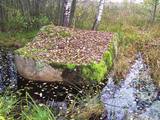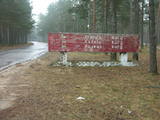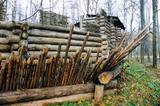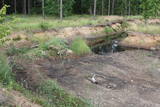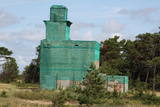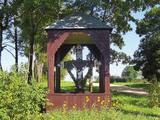| Нo | Название | Описание |
|---|---|---|
|
Кафе находится в центре города Екабпилс недалеко от Даугавы. Предлагаются помещения для проведения и организации банкетов и торжеств. Время работы: пн., вт., ср., чт.: 10:00 – 22:30; пт., сб.: 10:00 – 03:30; вс.: 11:00 – 22:30. |
||
|
Eine von Nadelbaumwäldern bedeckte Halbinsel. Malerisches Käsmu Steinfeld, Matsikivi Stein, Vana Jüri Stein u.a. Bei passenden Bedingungen kann man sich auf einer steinernen Landzunge bis zur 0,5 km entfernt liegenden Insel Saartneem schleppen. |
||
|
Представлена коллекция примерно из 2000 ложек из 70 пород дерева и кустов, которая создавалась более чем в течение 30 лет. Самая маленькая ложечка сделана из крушины, размеры наибольшей – «Европейской ложки» превышают рост человека. Мастер из дерева делает картины. Наблюдение за процессом гравировки, приобретение ложек и осмотр музея. |
||
|
Широкий камень. В волости Маконькалнс, недалеко от камня
Ажмугурас, на краю небольшого болота спит Широкий камень. В
отличие от своего соседа – плоский. Вокруг обоих камней завито
много рассказов. Один гласит, что камень Ажмугурас – часть
Широкого камня, а также, что накопившаяся дождевая вода во впадине Широкого камня может лечить
бородавки.
|
||
|
Plateļu dienviddaļā plešas sakoptais Plateļu muižas (muižas vēsture ir zināma, no 16. gs.) parks, kura centrā aug Raganu osis – dižkoks 7,2 m apkārtmērā. Parkā un tā tuvākajā apkārtnē ir redzamas muižas saimniecības ēkas. Vienā no tām – atjaunotajā zirgu stallī ir izveidots muzejs, kurā var apskatīt unikālas 250 vietējo meistaru darinātās maskas. Pašreiz šī ir lielākā šāda veida masku kolekcija Baltijas valstīs. Plateļu ezerā ir atrastas trīs no ozolkoka taisītas vienkoča laivas. Viena no tām (darināta 16. gs.) atrodas Lietuvas Jūras muzejā. Otra (15. gs.) ir apskatāma atjaunotajā Plateļu muižas graudu glabātavas pagrabā (Didžioji gatve 22), jo šobrīd tiek restaurēta. Trešā laiva arī izlikta apskatei kā muzeja eksponāts. |
||
|
Адажский полигон (бывший полигон армии СССР) и в наши дни используется для боевой стрельбы и тактических учений. На территории полигона можно организовать соревнования по авто- и мотоспорту, а также тестовые заезды или обучение военных (охранных) организаций, согласовывая заранее время проведения мероприятий. Наблюдение за растениями и животными на территории природного заказника. Гражданские лица могут посещать территорию только в установленном порядке.
|
||
|
The tower is at the western end of the Seda swamp, accessed from the side of Jērcēni. Transport is limited here. The tower is in the area of the swamp where peat moss is extracted. It offers a broad view of the ponds of Seda and a boat rental facility that is nearby. It is an appropriate location for bird-watching during the season of migration. There is another bird-watching platform near the town of Seda. This is part of the ZBR. |
||
|
Комплекс зданий построен как хозяйство рыбака и земледельца. В хозяйство входит жилой дом, построенный в 1926 году, и хозяйственные постройки (первая половина ХХ века). Хозяйство видно с дороги. |
||
|
Расположен в центральной части Лиелварде, на обочине шоссе Рига – Даугавпилс (А6). Реконструкция деревянного замка древних латышей XII века, созданная под руководством художника Агриса Лиепиньша. Эта визуализацияоснована на результатах исследования остатков древних строений, найденных в разных местах Латвии, и является версией автора о резиденции Улдевена – вождя племени Лиелвардского края. Внутри деревянного замка можно осмотретьзащитные сооружения крепости древних латышей XII – XIII вв. и имитацию жилых зданий, реконструкцию старинных нарядов. |
||
|
Nature restricted area has been established in old and overgrowing gravel pit and where rare species in Latvia - Natterjack toad (Bufo calamita) can be found. Natterjack toad needs open sand – gravel area therefore the population of it is decreasing once gravel pit is overgrowing by bushes. The population of this amphibian is depending on the activity of people in the area. There is very little chance to find Natterjack toad just by entering the restricted area, therefore please respect this area as especially sensitive.
|
||
|
A bridge for pedestrians and bicyclists, which is on the border of the Slītere National Park. |
||
|
This structure is smaller than the Great Kangari hills – approximately 10 kilometres long and 16 metres high. This structure is near the Buļļi swamp, and the restricted area is meant to protect the structure, the swamp and the various forest types and rare plants that are in the area.
|
||
|
The first church in Vecpiebalga was built in 1345, and the next one was built between 1839 and 1845 by the Livonian builder Mārcis Sārums. The church was destroyed in 1944 and restored between 1995 and 1997 (architect Ausma Skumiņa). The altar painting is titled “Christ Walking in the Land of Piebalga.” Outside the church is a rock to commemorate those who suffered from political repressions in Latvia. |
||
|
Onions, fish, villages that stretch out for several kilometres where the buildings are lined along the main street, ornate Old Believers' churches, small harbours with fishing boats and wooden houses, each painted in a different colour! Cafés, shops and a view of Lake Peipus, which looks more like a sea than a lake. This could be the description of this tour. This tour is a very interesting part of the Forest Trail, which will give you an opportunity to see and enjoy the Lake Peipsi region, the culture and lifestyle of local people as well as the nature. The tour will start in Tartu – Estonia’s second biggest city. You will go by bus from Tartu to Varnja where you will start to hike. During the tour you can visit Kostja’s onion farm, where the host welcomes guests and presents onion cultivation. It is also worth visiting the Chicory Museum in Kolkja to get acquainted with the history of chicory cultivation in row villages near Lake Peipus. You will also see Alatskivi Castle. In Avinurme we suggest visiting the Avinurme wooden handicraft centre and get acquainted with the local woodcraft, spend quality time in woodworking workshops and taste or even prepare yourself a selection of Estonian traditional foods. At the end of the tour you will return to Tartu by bus. |
||
|
Atrodas Viļānu dienviddaļā, Maltas upītes krastos, kuras tecējumu pārtrauc Viļānu HES. Par muižu atrodamas ziņas jau no 15. gs. beigām, kad tā piederēja bruņiniekam J. Loem. Līdzīgi kā Vidsmuiža, arī šī bija viena no Latgales lielākajām muižām, kurai piederēja zemes > 49 000 ha platībā. 18. - 19. gs. mijā ap muižu sāka veidoties Viļānu miests. Muižas dzīvojamo ēku, kas apskatāma tikai no ārpuses, ieskauj parks. |
||
|
This is a closed and guarded territory on the banks of Lake Būšnieks in Staldzene. The former project building is on the shore of the sea.
|
||
|
This is the 11th largest Estonian island, and its central section is covered by a broadleaf forest (linden, oak, elm and other trees) that is more than 100 years old. Along the shores, the Abruka Island has meadows and small areas of wetlands. Only the northern part of the island is populated. Few tourists come to call, which means that the island is relatively untouched by humankind.
|
||
|
The Crucifix of Ružina is made of wood according to old Latgalian traditions.
|
||
|
A very beautiful and expressive tree, it is found on the land of what was once the Vīceži Semi-estate.
|
||
|
Kalnbundas offer possibilities for active rest – horse-back riding and horse riding. |
||




